Changes Detected in Five Bioclimatic Indices in Large Romanian Cities over the Period 1961–2016
Abstract
1. Introduction
2. Data and Methods
2.1. Study Area
2.2. Data Used
2.3. Methods
2.3.1. Biometeorological Indices
TeK Calculation
TE Calculation
H Calculation
UTCI Calculation
THI Calculation
Thermal Comfort and Discomfort Classes
2.3.2. Calculating Indices Parameters
2.3.3. Trend Detection and Mapping Methods
3. Results
3.1. TeK Index
3.1.1. FO and DOP Spatial Distribution
3.1.2. Changes Detected in TeK Index Parameters
3.2. TE index
3.2.1. FO and DOP Spatial Distribution
3.2.2. Changes Detected in the TE Index Parameters
3.3. H Index
3.3.1. FO and DOP Spatial Distribution
3.3.2. Changes Detected in the H Index Parameters
3.4. UTCI Index
3.4.1. FO and DOP Spatial Distribution
3.4.2. Changes Detected in the UTCI Index Parameters
3.5. THI Index
3.5.1. FO and DOP Spatial Distribution
3.5.2. Changes Detected in the THI Index Parameters
4. Discussion and Conclusions
Author Contributions
Funding
Acknowledgments
Conflicts of Interest
References
- Frohlich, D.; Matzarakis, A. Spatial Estimation of Thermal Indices in Urban Areas—Basics of the SkyHelios Model. Atmosphere 2018, 9, 209. [Google Scholar] [CrossRef]
- Matthews, T. Humid Heat and Climate Change. Prog. Phys. Geogr. Earth Environ. 2018, 42, 391–405. [Google Scholar] [CrossRef]
- Fischer, E.M.; Knutti, R. Anthropogenic contribution to global occurrence of heavy-precipitation and high-temperature extremes. Nat. Clim. Chang. 2015, 5, 560–564. [Google Scholar] [CrossRef]
- Seneviratne, S.I.; Donat, M.G.; Mueller, B.; Alexander, L. No pause in the increase of hot temperature extremes. Nat. Clim. Chang. 2014, 4, 161–163. [Google Scholar] [CrossRef]
- Radinovic, D.; Curic, M. Measuring scales of daily temperature extremes, precipitation and wind velocity. Meteorol. Appl. 2014, 21, 461–465. [Google Scholar] [CrossRef]
- Steinemann, M.; Spescha, G.; von Stokar, T. Changement Climatique et Développement Territorial. Un Outil de Travail Pour Aménagistes; Office Fédéral du Developpement Territorial (ARE): Berne, Switzerland, 2013; Available online: http://www.are.admin.ch (accessed on 10 November 2019).
- OFEV (Ed.) 2018: Quand la Ville Surchauffe. Bases Pour un Développement Urbain Adapté aux Changements Climatiques; Connaissance de l’environnement, No 1812: 109 S; Office Fédéral de L’environnement: Berne, Switzerland, 2018; Available online: https://www.bafu.admin.ch/bafu/fr/home/themes/climat/publications-etudes/publications/quand-la-ville-surchauffe.html (accessed on 10 November 2019).
- Croitoru, A.-E.; Piticar, A.; Ciupertea, A.-F.; Roșca, C.F. Changes in heatwaves indices in Romania over the period 1961–2015. Glob. Planet. Chang. 2016, 146, 109–121. [Google Scholar] [CrossRef]
- Thornes, J.E.; Stephenson, D.B. How to judge the quality and value of weather forecasts products. Meteorol. Appl. 2001, 8, 307–314. [Google Scholar] [CrossRef]
- Spiridonov, V.; Curic, M.; Zafirovski, O. Weather and Human Health; National and University Library “St. Clement Ohridski”: Skopje, Macedonia, 2013; p. 344. [Google Scholar]
- Chen, L.; Ng, E. Outdoor thermal comfort and outdoor activities: A review of research in the past decade. Cities 2012, 29, 118–125. [Google Scholar] [CrossRef]
- Kantor, N.; Unger, J.; Gulyas, A. Subjective estimations of thermal environment in recreational urban spaces—Part 2: International comparison. Int. J. Biometeorol. 2012, 56, 1089–1101. [Google Scholar] [CrossRef]
- Blazejczyk, K.; Twardosz, R. Long-Term Changes of Bioclimatic Conditions in Cracow (Poland). In The Polish Climate in the European Context: An Historical Overview; Przybylak, R., Ed.; Springer: Dordrecht, The Netherlands, 2010. [Google Scholar]
- Petralli, M.; Massetti, L.; Orlandini, S. Five years of thermal intra-urban monitoring in Florence (Italy) and application of climatological indices. Theor. Appl. Clim. 2010, 104, 349–356. [Google Scholar] [CrossRef]
- Radinovic, D.; Curic, M. Criteria for heat and cold waves duration indexes. Theor. Appl. Climatol. 2012, 107, 505–510. [Google Scholar] [CrossRef]
- Omonijo, A.G.; Adeofun, C.O.; Oguntoke, O.; Matzarakis, A. Relevance of thermal environment to human health: A case study of Ondo State, Nigeria. Theor. Appl. Clim. 2012, 113, 205–212. [Google Scholar] [CrossRef]
- Błażejczyk, K.; Kuchcik, M.; Błażejczyk, A.; Milewski, P.; Szmyd, J. Assessment of urban thermal stress by UTCI—Experimental and modelling studies: An example from Poland. DIE ERDE J. Geogr. Soc. Berl. 2014, 145, 16–33. [Google Scholar]
- Kalbarczyk, R.; Sobolewski, R.; Kalbarczyk, E. Assessement of human thermal sensations based on bioclimatic indices in a suburban population, Wroclaw (SW Poland). Pol. J. Nat. Sci. 2015, 30, 185–201. [Google Scholar]
- Toy, S.; Aytac, A.S.; Kantor, N. Human biometeorological analysis of the thermal conditions of the hot Turkish city of Sanliurfa. Theor. Appl. Climatol. 2016, 131, 611–623. [Google Scholar] [CrossRef]
- Reinhart, C.F.; Dhariwal, J.; Gero, K. Biometeorological indices explain outside dwelling patterns based on Wi-Fi data in support of sustainable urban planning. Build. Environ. 2017, 126, 422–430. [Google Scholar] [CrossRef]
- Charalampopoulos, I.; Tsiros, I.; Chronopoulou-Sereli, A.; Matzarakis, A. A methodology for the evaluation of the human-bioclimatic performance of open spaces. Theor. Appl. Clim. 2016, 128, 811–820. [Google Scholar] [CrossRef]
- Lindner-Cendrowska, K.; Blazejczyk, K. Impact of selected personal factors on seasonal variability of recreationist weather perceptions and preferences in Warsaw (Poland). Int. J. Biometeorol. 2016, 62, 113–125. [Google Scholar] [CrossRef]
- Lokys, H.L.; Junk, J.; Krein, A. Short-term effects of air quality and thermal stress on non-accidental morbidity—A multivariate meta-analysis comparing indices to single measures. Int. J. Biometeorol. 2017, 62, 16–27. [Google Scholar] [CrossRef]
- Mohammadi, B.; Karimi, S. The relationship between thermal sensation and the rate of hospital admissions for cardiovascular disease in Kermanshah, Iran. Theor. Appl. Clim. 2017, 134, 1101–1114. [Google Scholar] [CrossRef]
- Geletic, J.; Lehnert, M.; Savic, S.; Milosevic, D. Modelled spatiotemporal variability of outdoor thermal confort in local climate zones of the city of Brno, Czech Republic. Sci. Total Environ. 2018, 624, 385–395. [Google Scholar] [CrossRef] [PubMed]
- Lin, T.-P.; Yang, S.-R.; Chen, Y.-C.; Matzarakis, A. The potential of a modified physiologically equivalent temperature (mPET) based on local thermal confort perception in hot and humid regions. Theor. Appl. Climatol. 2019, 135, 873–876. [Google Scholar] [CrossRef]
- Perry, M.; Hollis, D. The generation of monthly gridded datasets for a range of climatic variables over the UK. Int. J. Clim. 2005, 25, 1041–1054. [Google Scholar] [CrossRef]
- Krüger, E.L.; Rossi, F.; Drach, P. Calibration of the physiological equivalent temperature index for three different climatic regions. Int. J. Biometeorol. 2017, 61, 1323–1336. [Google Scholar] [CrossRef]
- Ionac, N. Clima și Comportamentul Uman; Enciclopedică: București, Romania, 1998; p. 272. [Google Scholar]
- Ionac, N. Mic Tratat de Geografie Medicală; Editura Universității din București: București, Romania, 2000; p. 428. [Google Scholar]
- Teodoreanu, E. Bioclimatologie Umană; Editura Academiei Române: Bucharest, Romania, 2002; p. 215. [Google Scholar]
- Teodoreanu, E. Geografie Medicală; Editura Academiei Române: Bucharest, Romania, 2004; p. 144. [Google Scholar]
- Teodoreanu, E. Clima și Omul, Prieteni Sau Dușmani; Paideia: Bucharest, Romania, 2011; p. 380. [Google Scholar]
- Teodoreanu, E. Turismul Balneoclimatic in România; Editura Universității din Oradea: Oradea, Romania, 2013; p. 228. [Google Scholar]
- Croitoru, A.-E.; Sorocovschi, V. Introducere în Biometeorologia Umană; Casa Cărții de Știință: Cluj-Napoca, Romania, 2012; p. 200. [Google Scholar]
- Ionac, N.; Ciulache, S. Atlasul Bioclimatic al României; Ars Docendi: București, Romania, 2008; p. 279. [Google Scholar]
- Grigore, E. Potențialul Bioclimatic al Podișului Dobrogei de Sud. Ph.D. Thesis, Universitatea din București, Bucharest, Romania, 2011. [Google Scholar]
- Ciobotaru, A.-M.; Andronache, I.; Dey, N.; Petralli, M.; Daneshavr, M.R.M.; Wang, Q.; Radulovic, M.; Pintilii, R.-D. Temperature-Humidity Index described by fractal Higuchi Dimension affects tourism activity in the urban environment of Focșani City (Romania). Theor. Appl. Climatol. 2018, 136, 1009–1019. [Google Scholar] [CrossRef]
- Croitoru, A.-E.; Piticar, A. Changes in daily extreme temperatures in the extra—Carpathians regions of Romania. Int. J. Climatol. 2013, 33, 1987–2001. [Google Scholar] [CrossRef]
- Busuioc, A.; Caian, M.; Cheval, S.; Bojariu, R.; Boroneant, C.; Baciu, M.; Dumitrescu, A. Variabilitatea si Schimbarea Climei in Romania; Pro Universitaria: Bucharest, Romania, 2010. [Google Scholar]
- Bojariu, R.; Bîrsan, M.V.; Cica, R.; Velea, L.; Burcea, S.; Dumitrescu, A.; Dascalu, S.I.; Gothard, M.; Dobrinescu, A.; Carbunaru, F.; et al. Schimbarile Climatice—De la Bazele Fizice la Riscuri si Adaptare; Printech: Bucharest, Romania, 2015; p. 200. [Google Scholar]
- Croitoru, A.E.; Piticar, A.; Burada, D.C. Changes in precipitation extremes in Romania. Quat. Int. 2016, 415, 325–335. [Google Scholar] [CrossRef]
- Croitoru, A.E.; Piticar, A.; Sfîca, L.; Harpa, G.V.; Rosca, C.F.; Tudose, T.; Horvath, C.; Minea, I.; Ciupertea, F.A.; Scripca, A.S. Extreme Temperature and Precipitation Events in Romania; Editura Academiei Române: Bucharest, Romania, 2018; pp. 320–359. [Google Scholar]
- Tank, A.M.G.K.; Wijngaard, J.B.; Können, G.P.; Böhm, R.; Demarée, G.; Gocheva, A.; Mileta, M.; Pashiardis, S.; Hejkrlik, L.; Kern-Hansen, C.; et al. Daily dataset of 20th-century surface air temperature and precipitation series for the European Climate Assessment. Int. J. Clim. 2002, 22, 1441–1453. [Google Scholar] [CrossRef]
- Meteomanz. Available online: http://www.meteomanz.com (accessed on 13 October 2017).
- Rp5. Available online: http://www.rp5.ru (accessed on 13 October 2017).
- Baranowska, M.; Gabryl, B. Biometeorological norms as tolerance interval of man to weather stimuli. Int. J. Biometeorol. 1981, 25, 515–535. [Google Scholar] [CrossRef]
- Blazejczyk, K.; Epstein, Y.; Jendritzky, G.; Staiger, H.; Tinz, B. Comparison of UTCI to selected thermal indices. Int. J. Biometeorol. 2012, 56, 515–535. [Google Scholar] [CrossRef]
- Malcheva, K.; Gocheva, A. Thermal confort indices for the cold half-year in Sofia. Bulg. J. Meteol. Hydrol. 2014, 19, 16–25. [Google Scholar]
- Scripcă, A.-S.; Croitoru, A.-E. L’évaluation générale du stress thermique dans les grandes zones urbaines de Roumanie. In Actes du Colloque—Les Risques Naturels Dans le Contexte du Changement Climatique. Résumés Étendus; Holobâcă, I.-H., Ivan, K., Eds.; Presa Universitară Clujeană: Cluj-Napoca, Romania, 2018; pp. 105–111. [Google Scholar]
- Scripcă, A.-S.; Croitoru, A.-E. Analyse de la relation entre les indices bioclimatiques et les vagues de chaleur/periodes chaudes à Bucarest, en Roumanie. In XXXIIème Colloque Internationale de L’AIC—Le Changement Climatique, la variabilité et les Risques Climatiques/Climatic Change, Variability and Climatic Risks; Department of Meteorology and Climatology, Aristotle University of Thessaloniki: Thessaloniki, Greece, 2019; pp. 511–516. [Google Scholar]
- Bioklima. Available online: https://www.igipz.pan.pl/bioklima.html (accessed on 20 February 2018).
- Katabatic Power. Available online: https://websites.pmc.ucsc.edu/~jnoble/wind/extrap/ (accessed on 15 May 2019).
- Dufton, A.F. Equivalent temperature of a room and its measurement. In Building Research Board; Technical Paper 13; H. M. Stationery Office: London, UK, 1932; p. 9. [Google Scholar]
- Dufton, A.F. The use of kata thermometers for the measurement of equivalent temperature. Epidemiol. Infect. 1933, 33, 349–352. [Google Scholar] [CrossRef] [PubMed][Green Version]
- Bedford, T. Equivalent temperature, what it is, how it’s measured. Heat. Pip. Air cond. 1951, 23, 87–91. [Google Scholar]
- Farajzadeh, H.; Saligheh, M.; Alijani, B.; Matzarakis, A. Comparison of selected thermal indices in the northwest of Iran. Nat. Environ. Chang. 2015, 1, 61–80. [Google Scholar]
- Kozłowska-Szczȩsna, T.; Błażejczyk, K.; Krawczyk, B. Human Bioclimatology—Methods and Applications. Monographies, 1; Polish Academy of Sciences: Warsow, Poland, 1997; p. 200. [Google Scholar]
- Araźny, A. Biometeorological Conditions in the Arctic during the First International Polar Year, 1882–1883. Bull. Geogr. Phys. Geogr. Ser. 2010, 3, 47–64. [Google Scholar] [CrossRef][Green Version]
- Hill, L.; Griffith, O.W.; Flack, M.V. The measurement of the rate of heat-loss at body temperature by convection, radiation, and evaporation. Philos. Trans. R. Soc. Lond. Ser. B Contain. Pap. Boil. Character 1916, 207, 183–220. [Google Scholar]
- Błażejczyk, K.; Kozłowska-Szczęsna, T.; Krawczyk, B. Recent bioclimatological studies in Poland. Geogr. Pol. 1994, 63, 37–49. [Google Scholar]
- Zare, S.; Hasheminejad, N.; Shirvan, H.E.; Hemmatjo, R.; Sarebanzadeh, K.; Ahmadi, S. Comparing Universal Thermal Climate Index (UTCI) with selected thermal indices/environmental parameters during 12 months of the year. Weather Clim. Extrem. 2018, 19, 49–57. [Google Scholar]
- Błażejczyk, K.; Baranowski, J.; Jendritzky, G.; Błażejczyk, A.; Bröde, P.; Fiala, D. Regional features of the bioclimate of Central and Southern Europe against the background of the Köppen-Geiger climate classification. Geogr. Pol. 2015, 88, 439–453. [Google Scholar] [CrossRef]
- Błażejczyk, K. Radiation balance in man in various meteorological and geographical conditions. Geogr. Pol. 2004, 77, 63–76. [Google Scholar]
- Błażejczyk, K. Radiation balance of different segments of the human body, DWD. Ann. Meteorol. 2005, 41, 313–316. [Google Scholar]
- Błażejczyk, K.; Matzarakis, A. Assessment of bioclimatic differentiation of Poland based on the human heat balance. Geo. Pol. 2007, 80, 63–82. [Google Scholar]
- Błażejczyk, A.; Błażejczyk, K.; Baranowski, J.; Kuchcik, M. Heat stress mortality and desired adaptation responses of healthcare system in Poland. Int. J. Biometeorol. 2018, 62, 307–318. [Google Scholar] [CrossRef] [PubMed]
- Bligh, J.; Johnson, K.G. Glossary of Terms for Thermal Physiology. J. Therm. Biol. 2003, 28, 75–106. [Google Scholar] [CrossRef] [PubMed]
- UTCI. Available online: http://www.utci.org (accessed on 24 June 2019).
- Mann, H.B. Non-parametric tests against trend. Ecometrica 1945, 13, 245–259. [Google Scholar] [CrossRef]
- Kendall, M.G. Rank Correlation Method, 4th ed.; Charles Griffin: London, UK, 1975; p. 202. [Google Scholar]
- Gilbert, R.O. Statistical Methods for Environmental Pollution Monitoring; Van Nostrand Reinhold: New York, NY, USA, 1987; p. 320. [Google Scholar]
- Corpade, C.; Man, T.; Petrea, D.; Corpade Ana-Maria Moldovan, C. Changes in landscape structure induced by transportation projects in Cluj-Napoca periurban area using GIS. Carpathian J. Earth Environ. Sci. 2014, 9, 177–184. [Google Scholar]
- Kil, J.; Kowalczyk, C.; Moldovan, C.S. Comparison of changes in urbanized area in Poland and Romania. Transylv. Rev. 2018, 27, 56–72. [Google Scholar]
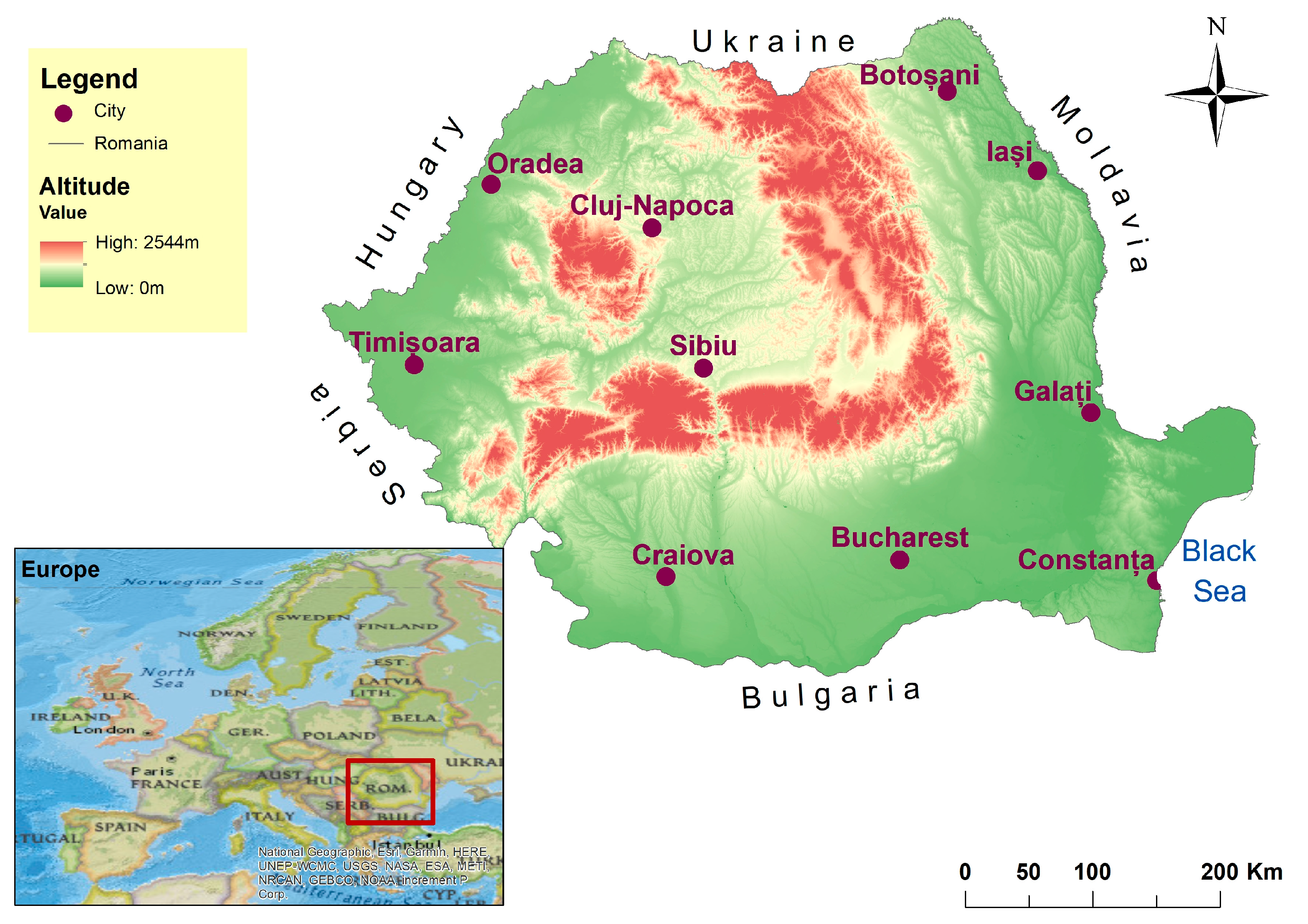
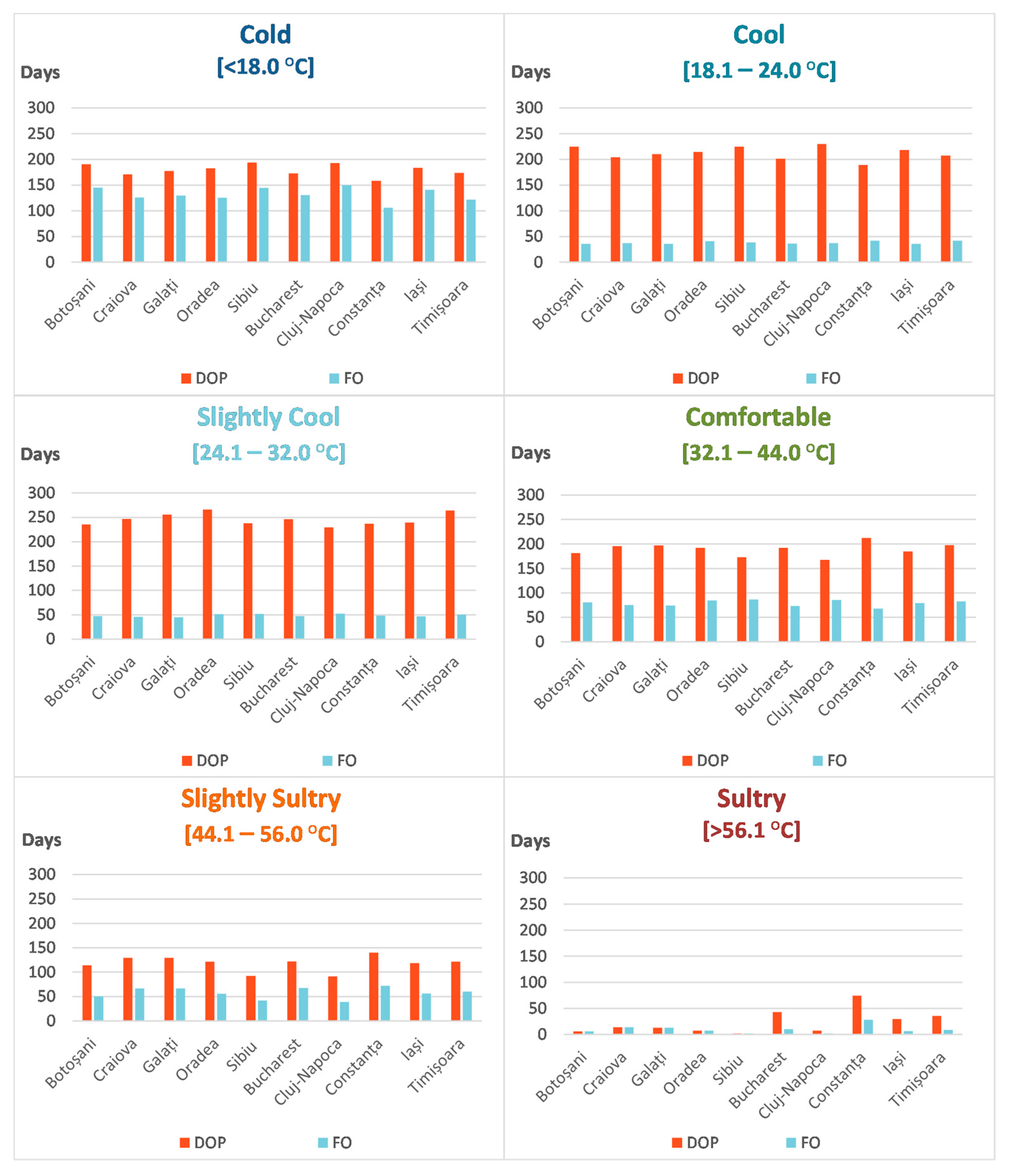
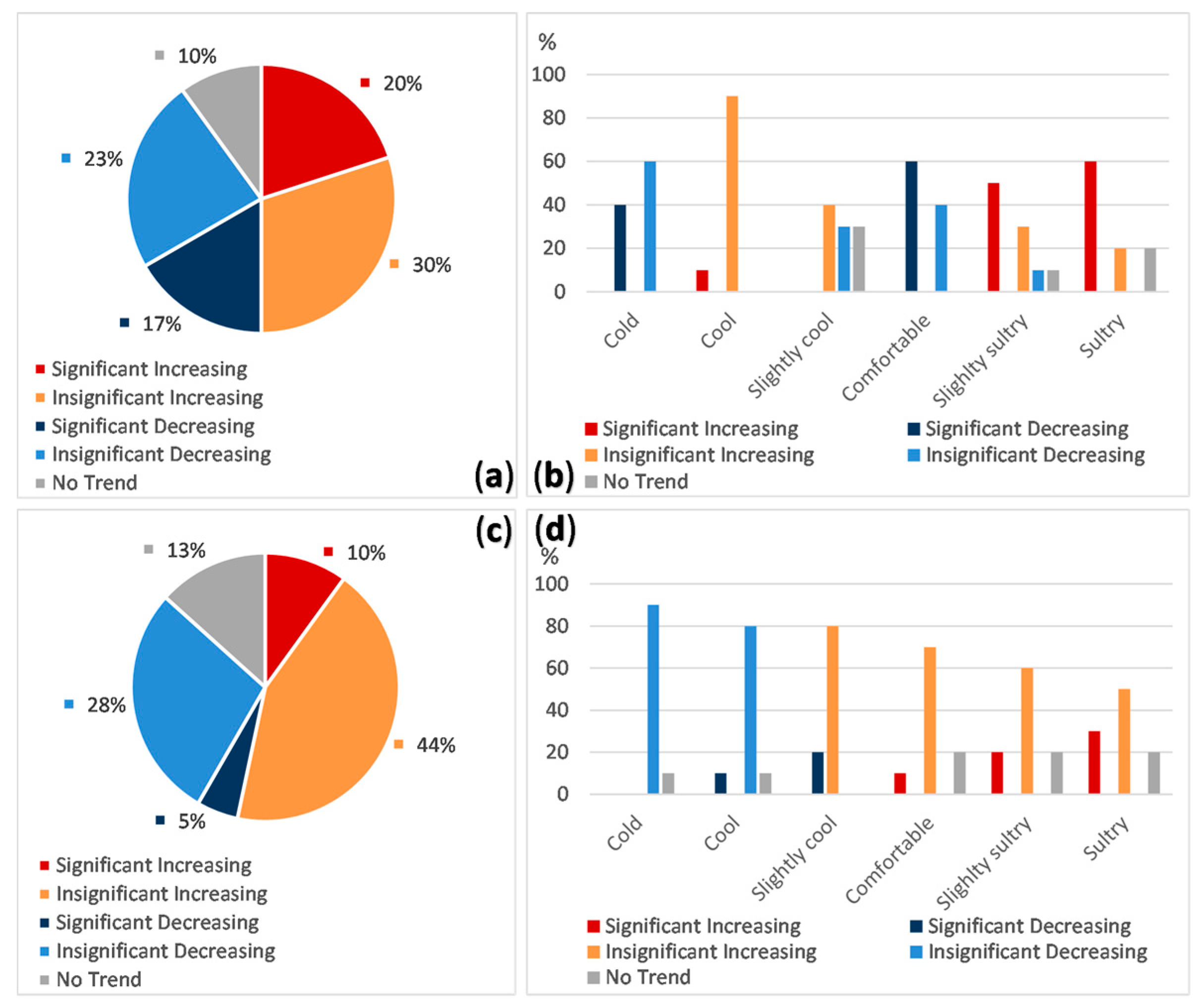
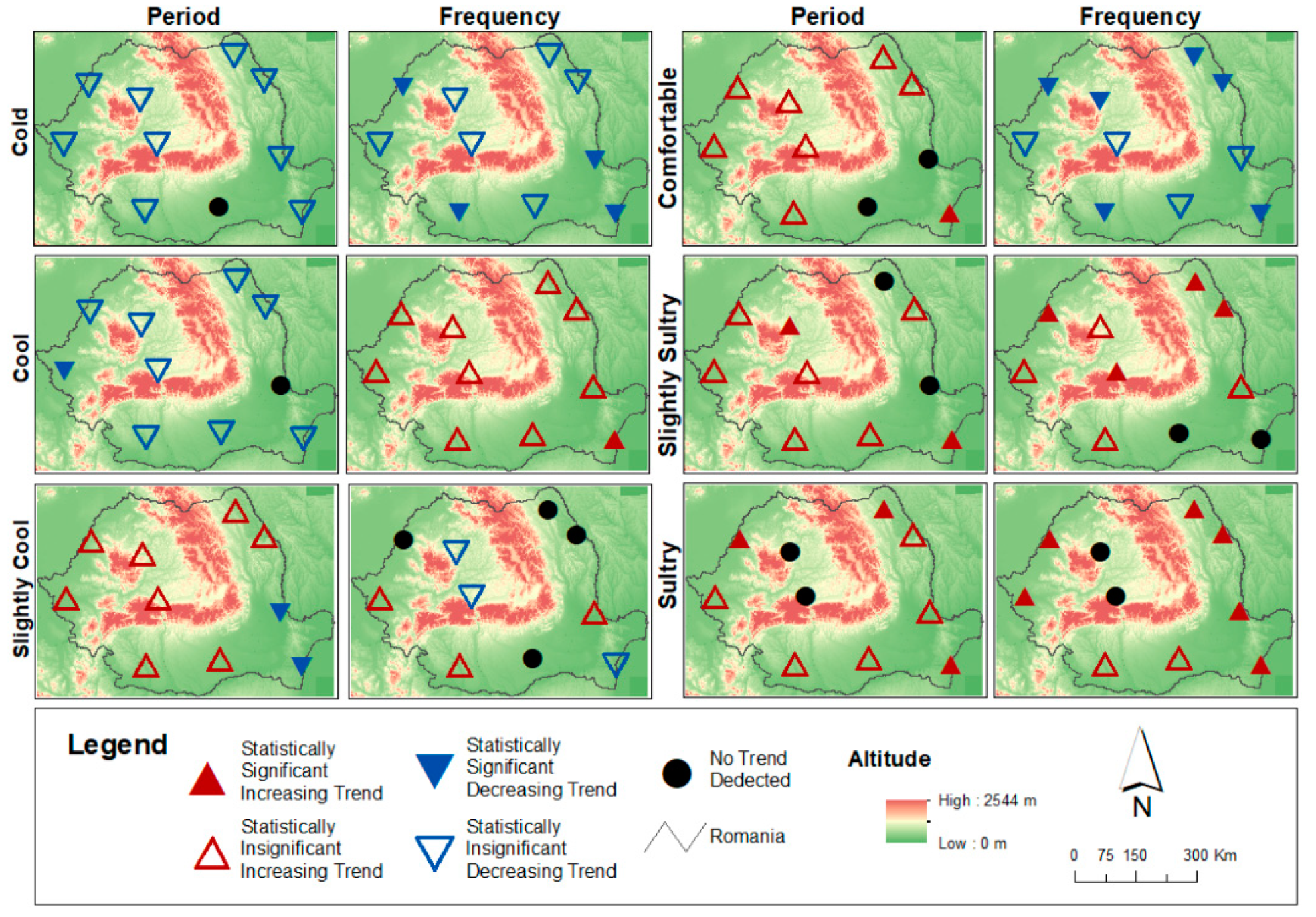
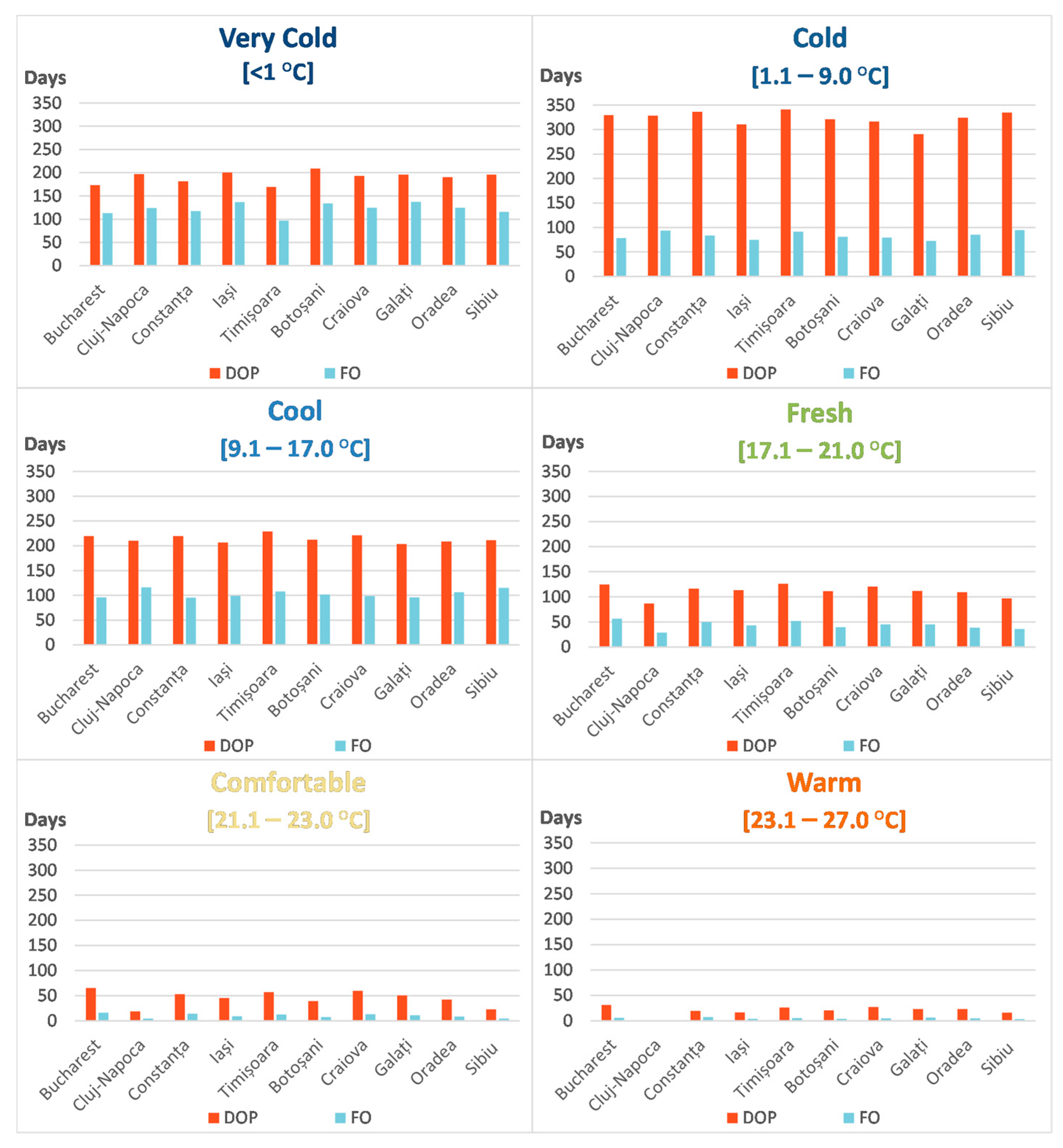
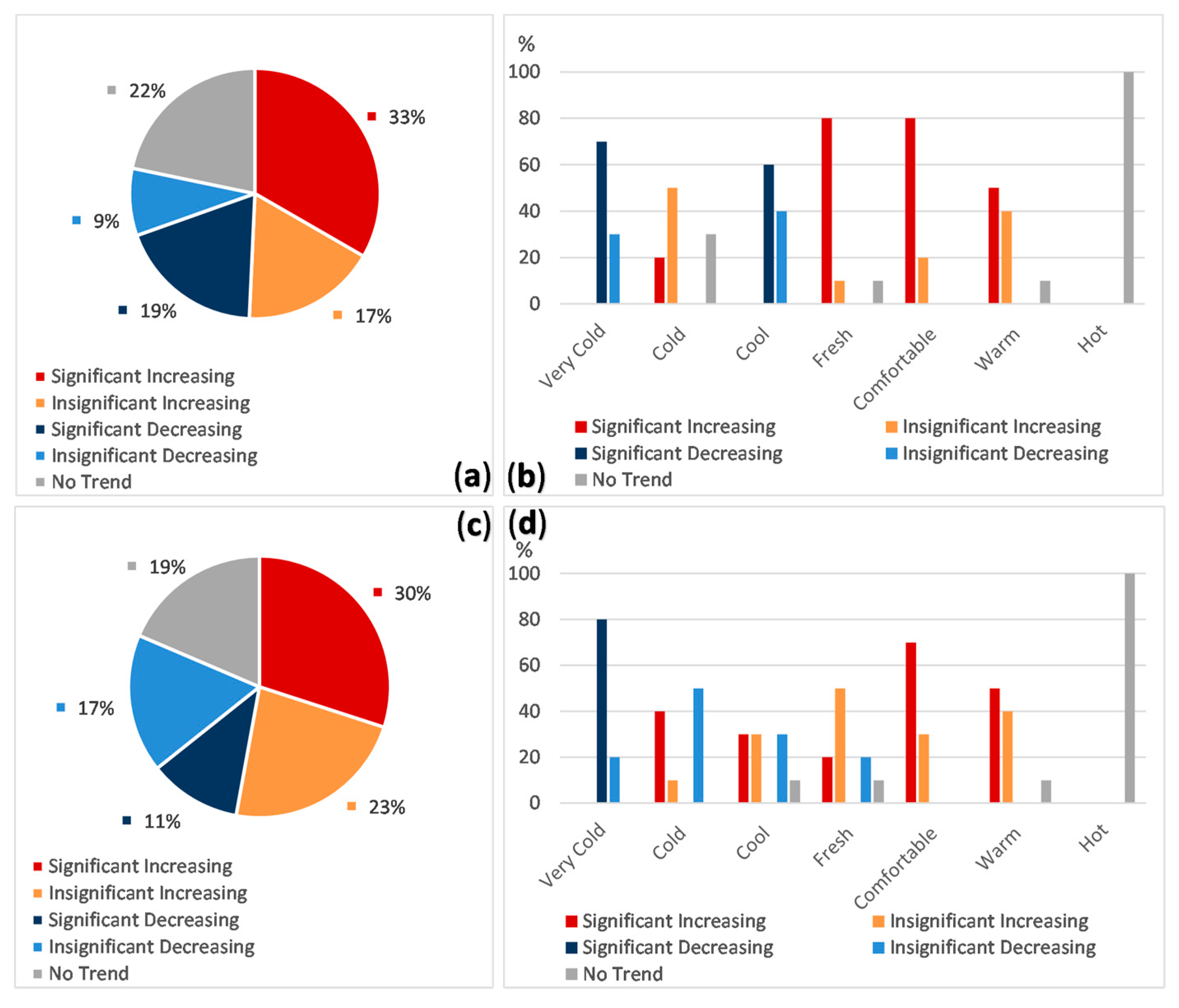
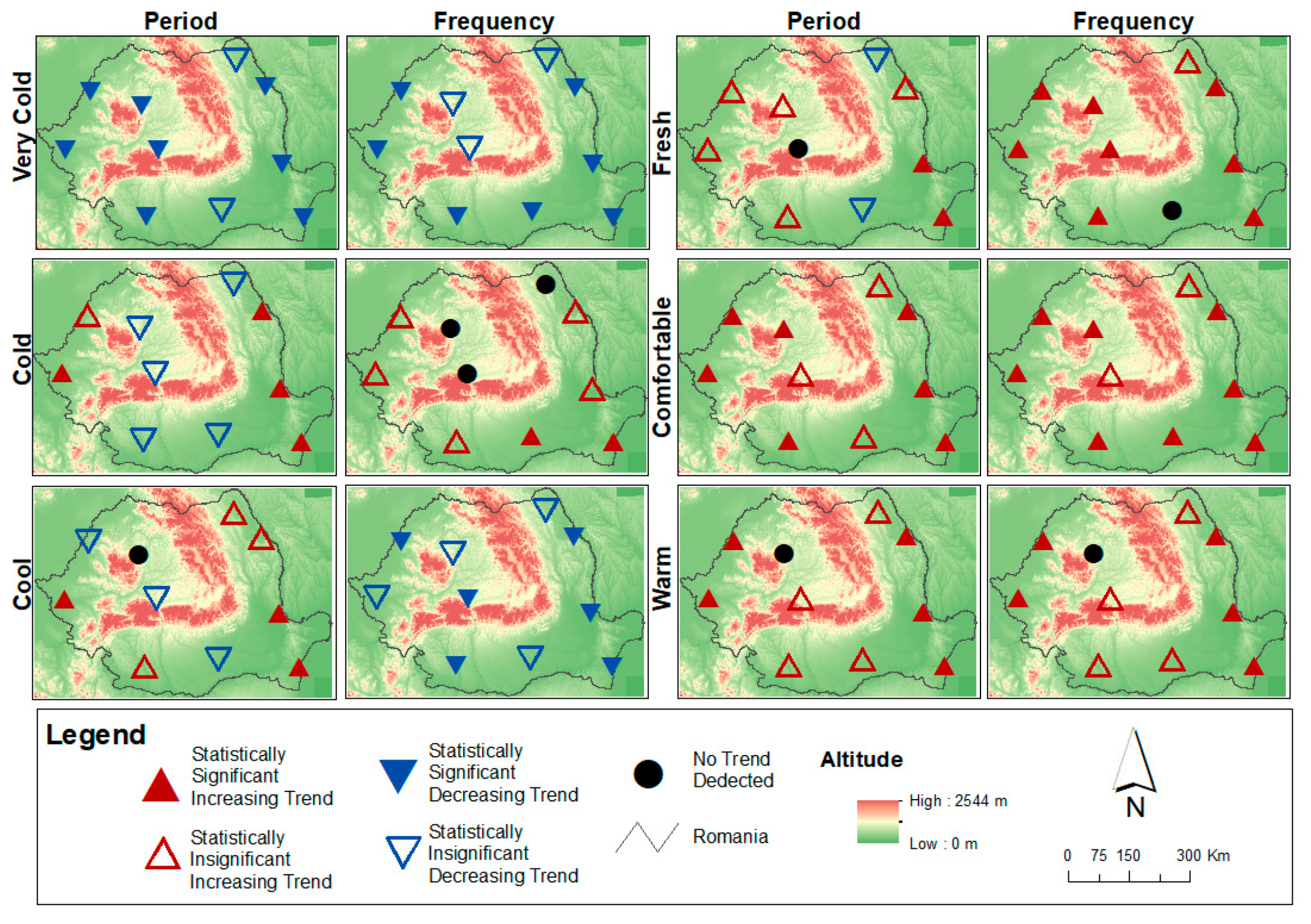
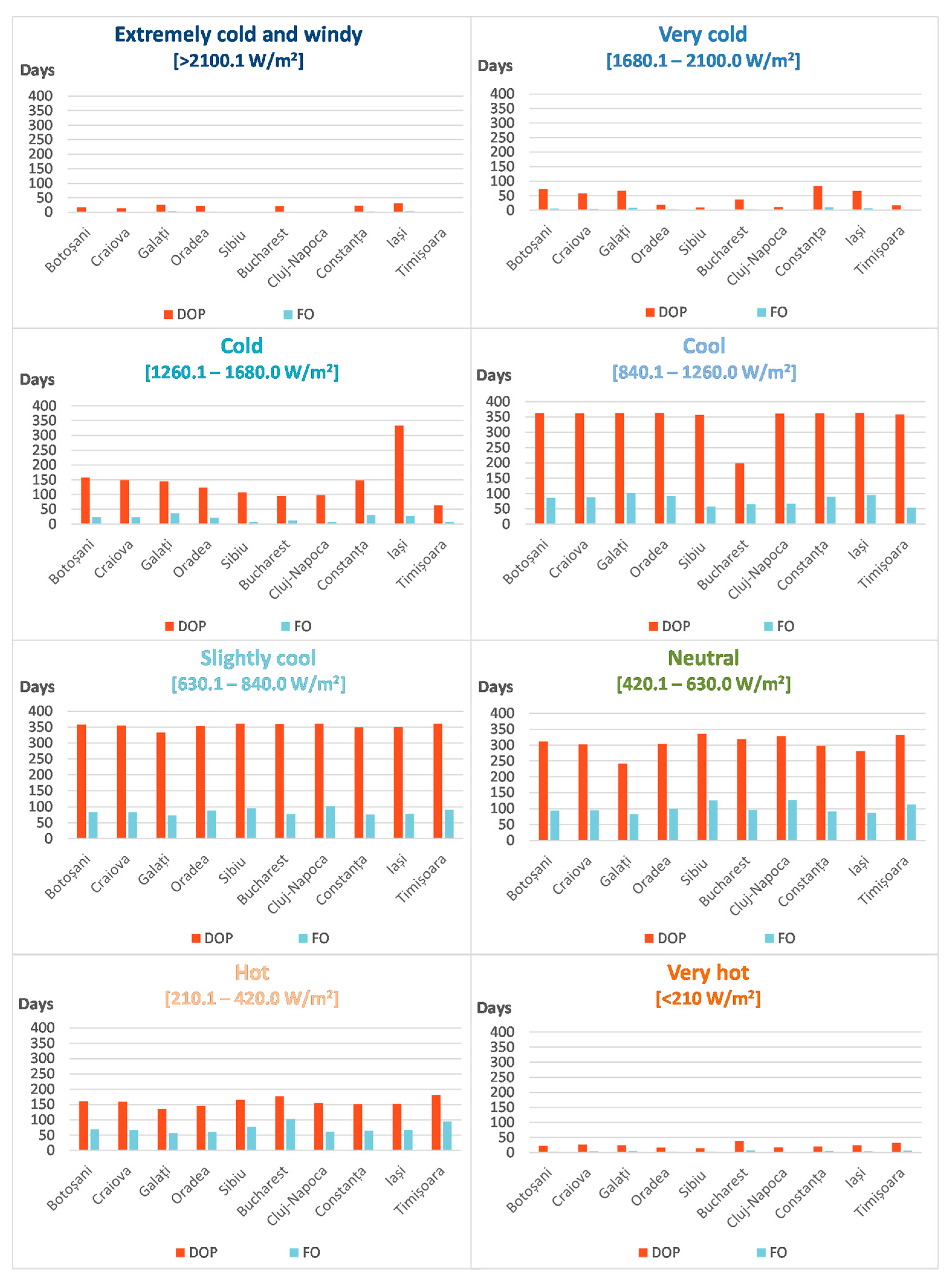
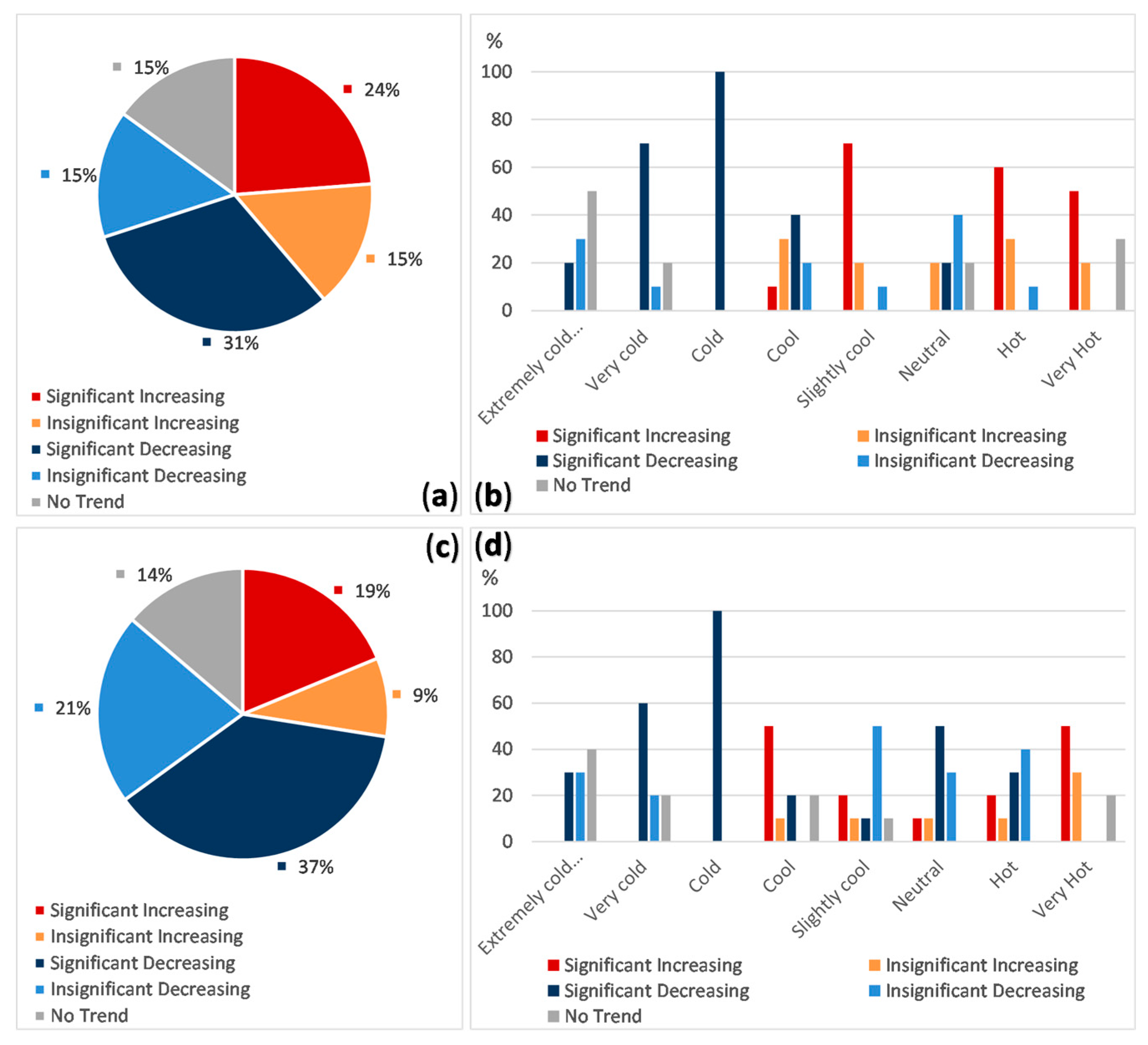
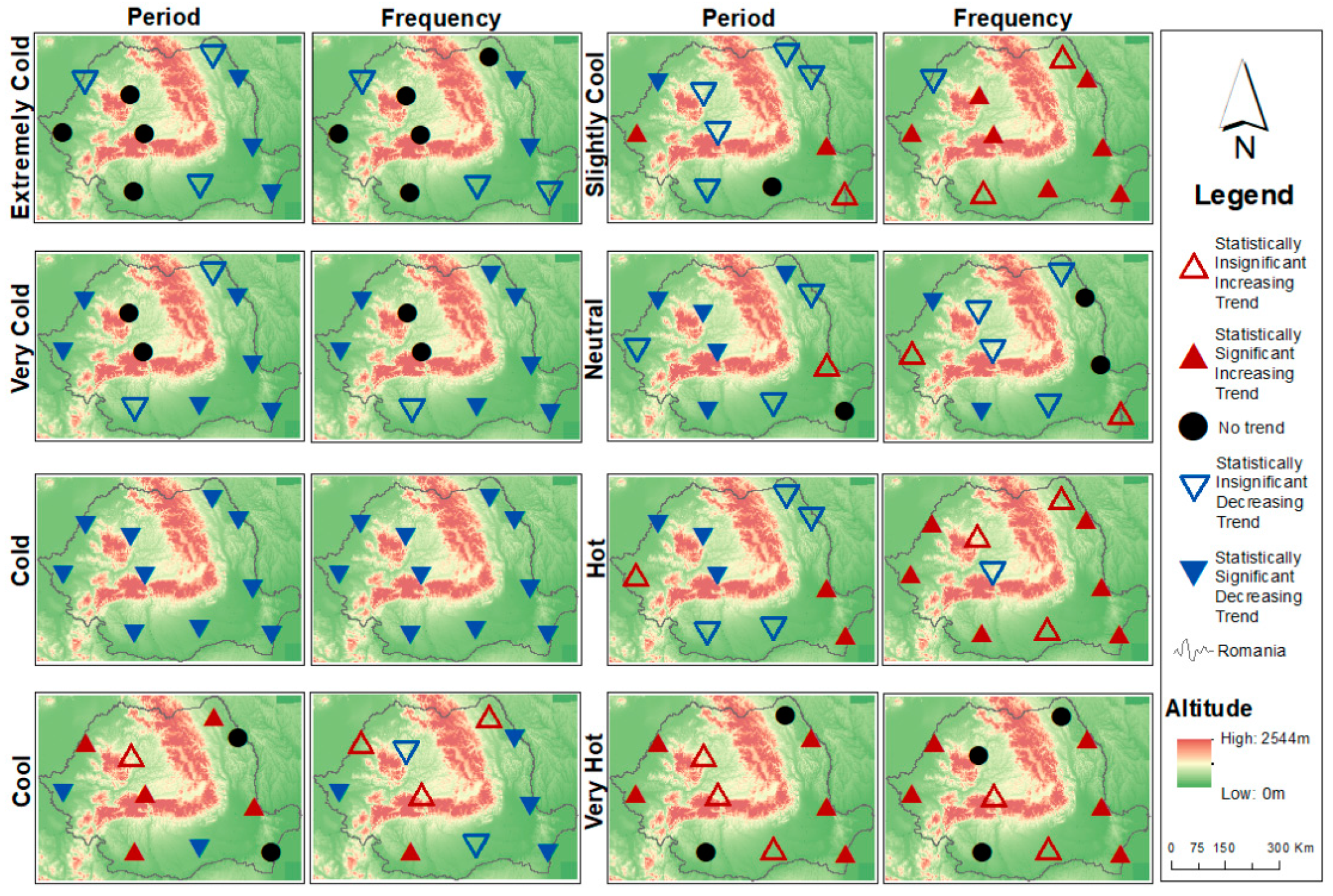
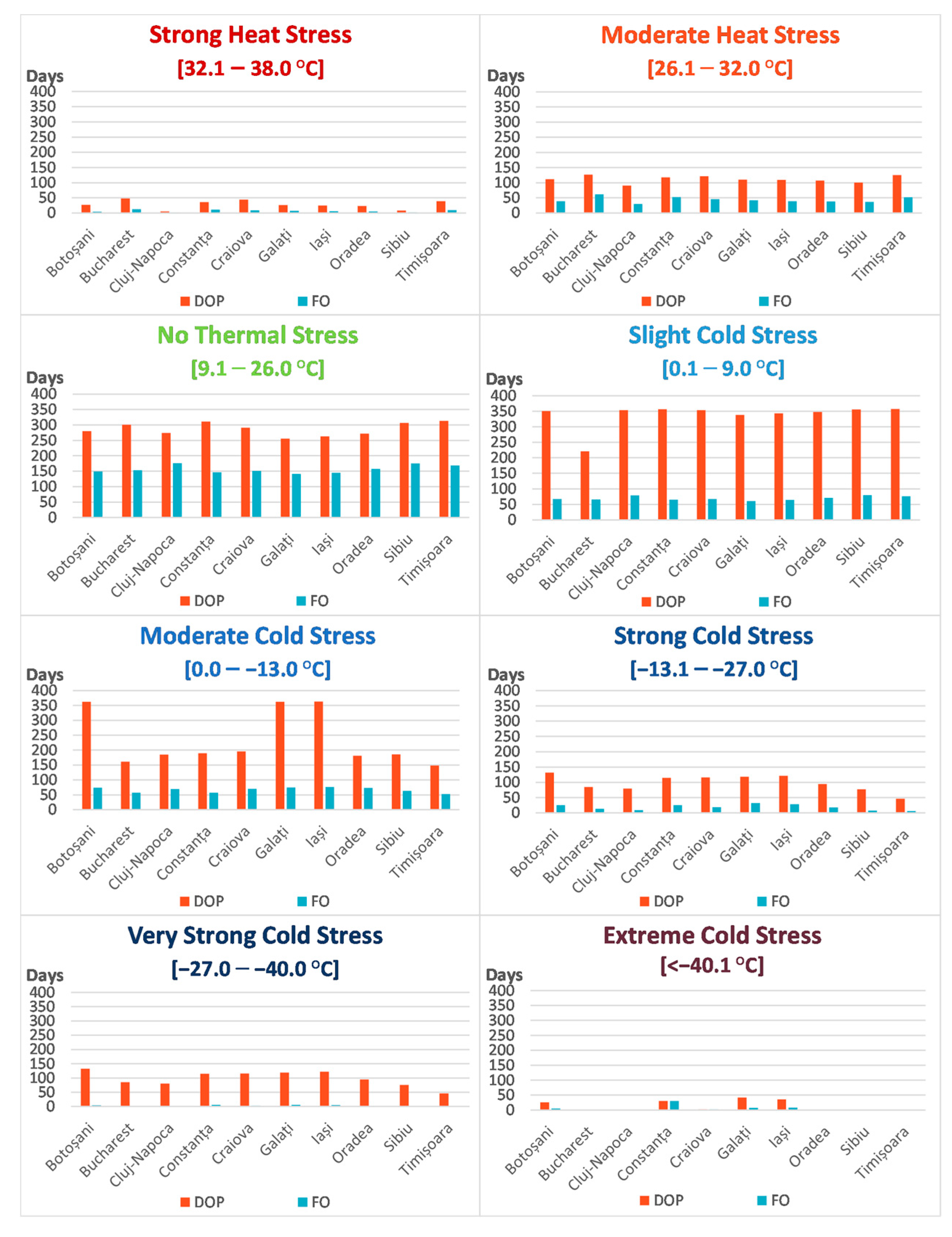
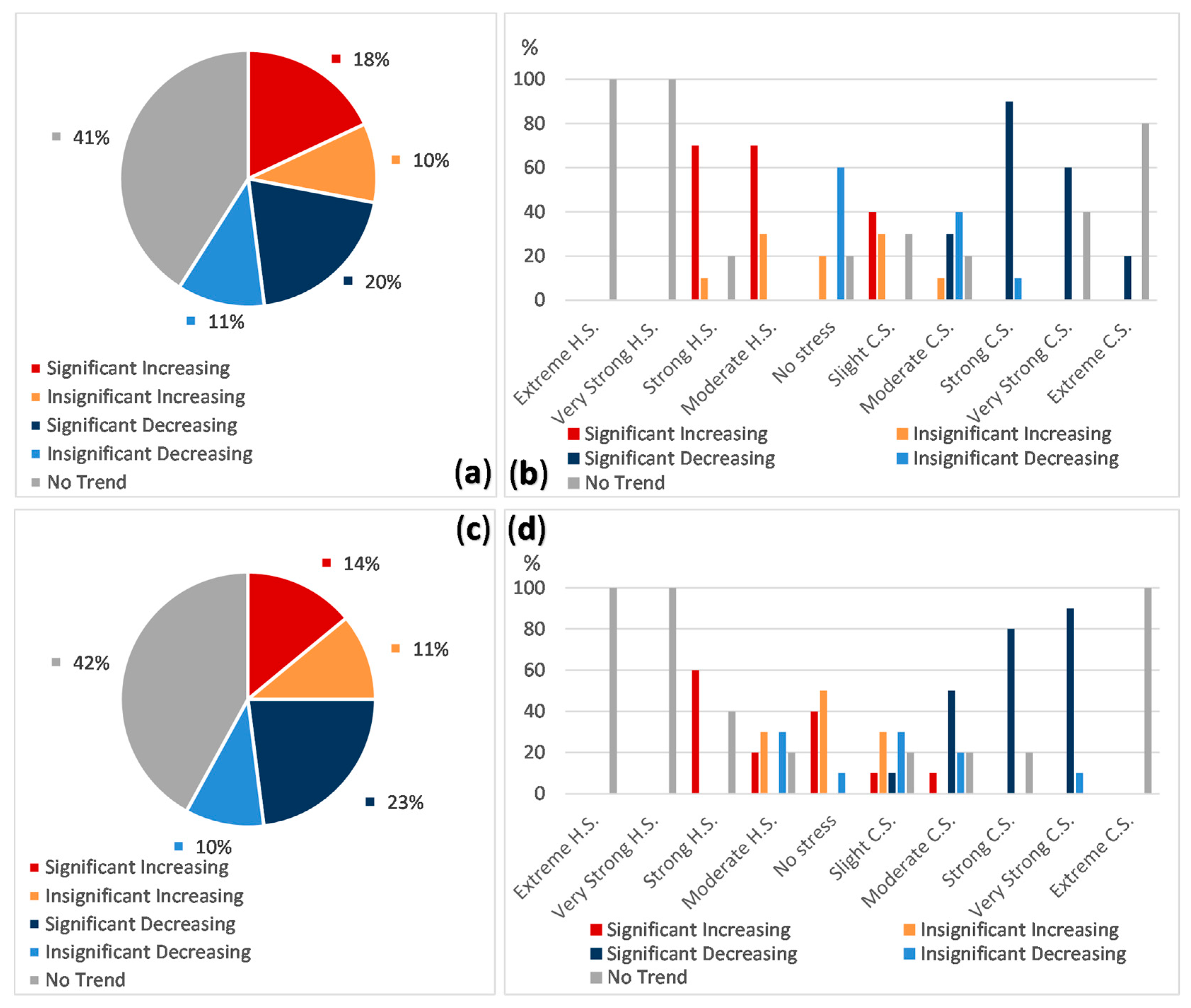
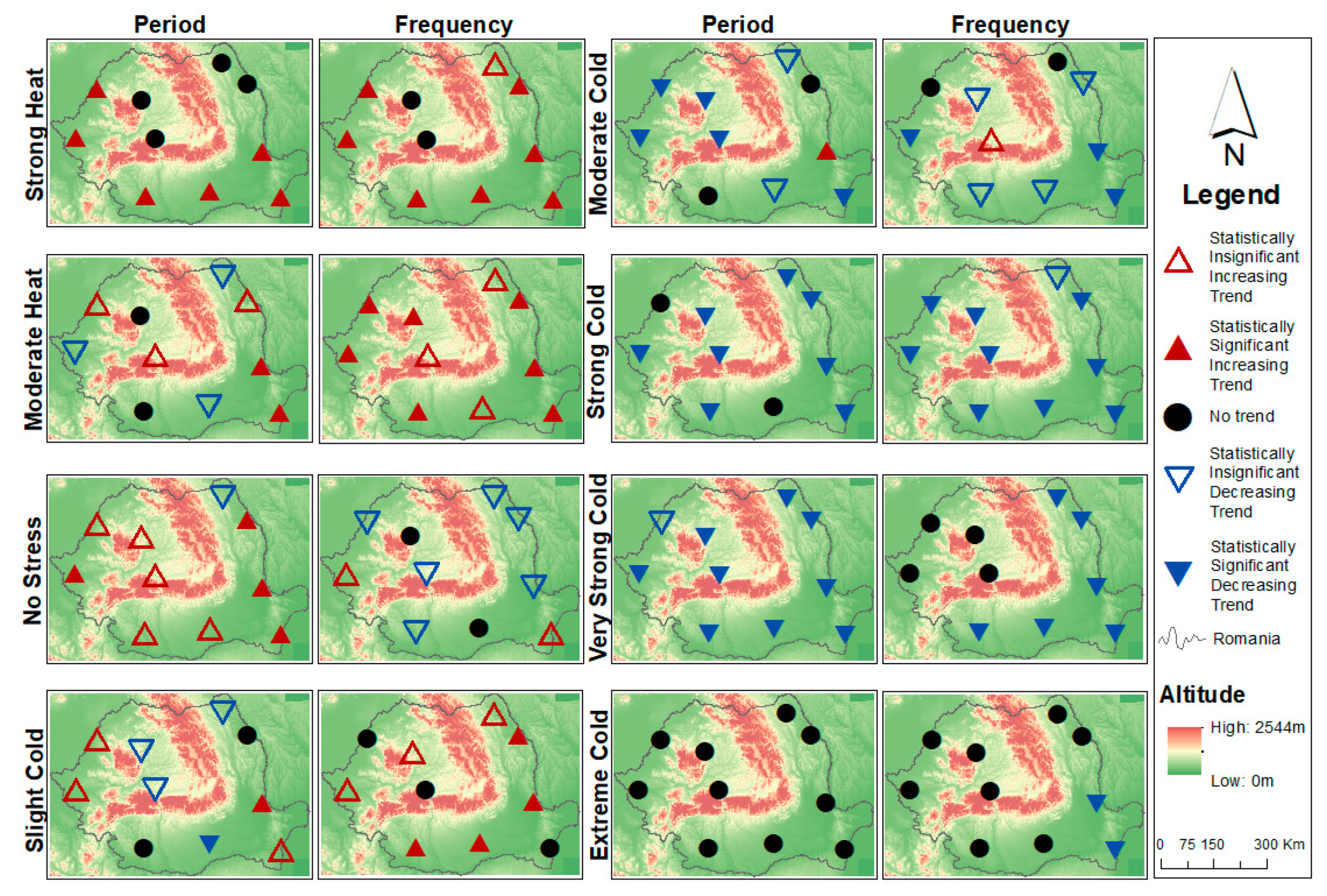
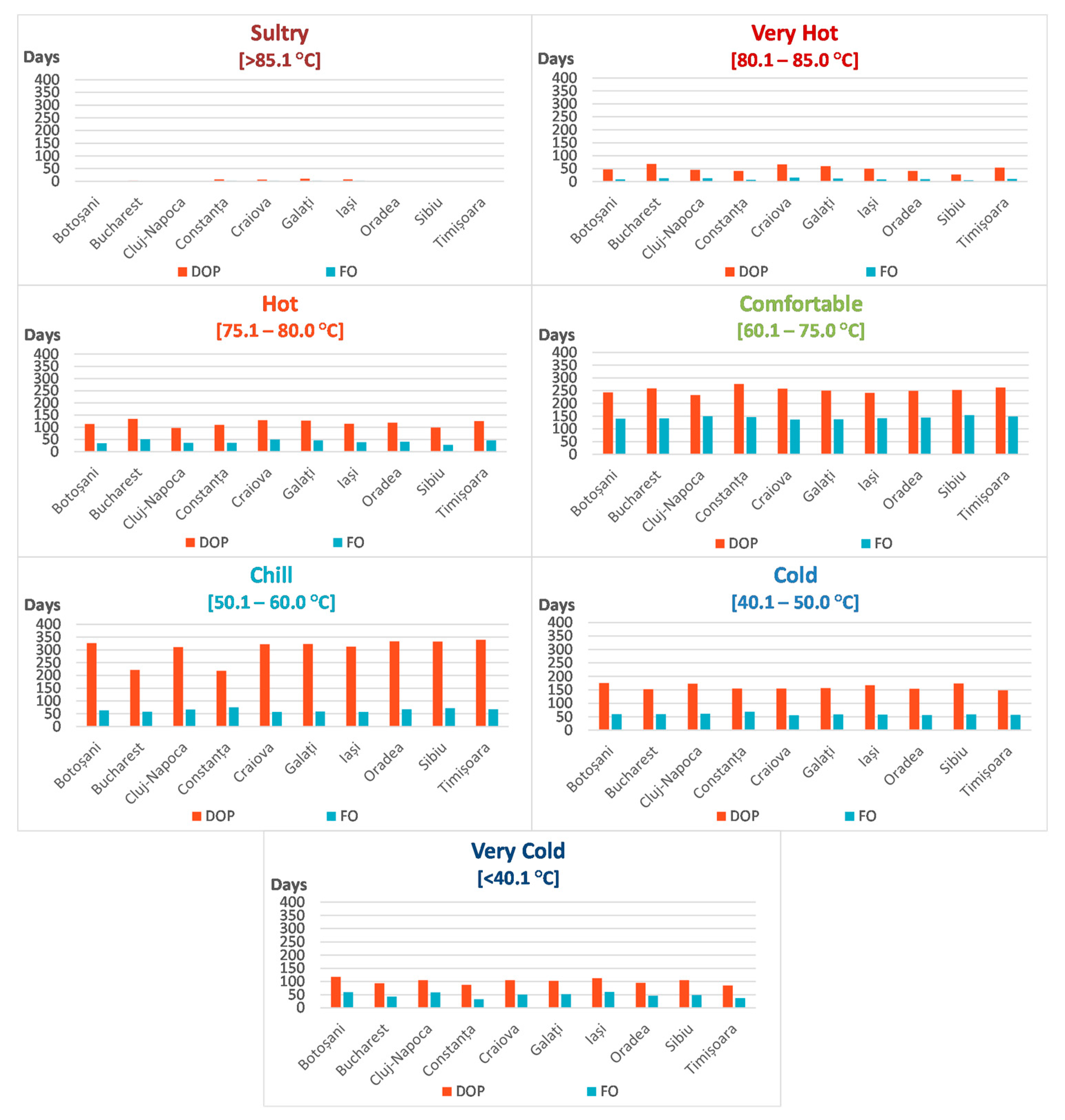
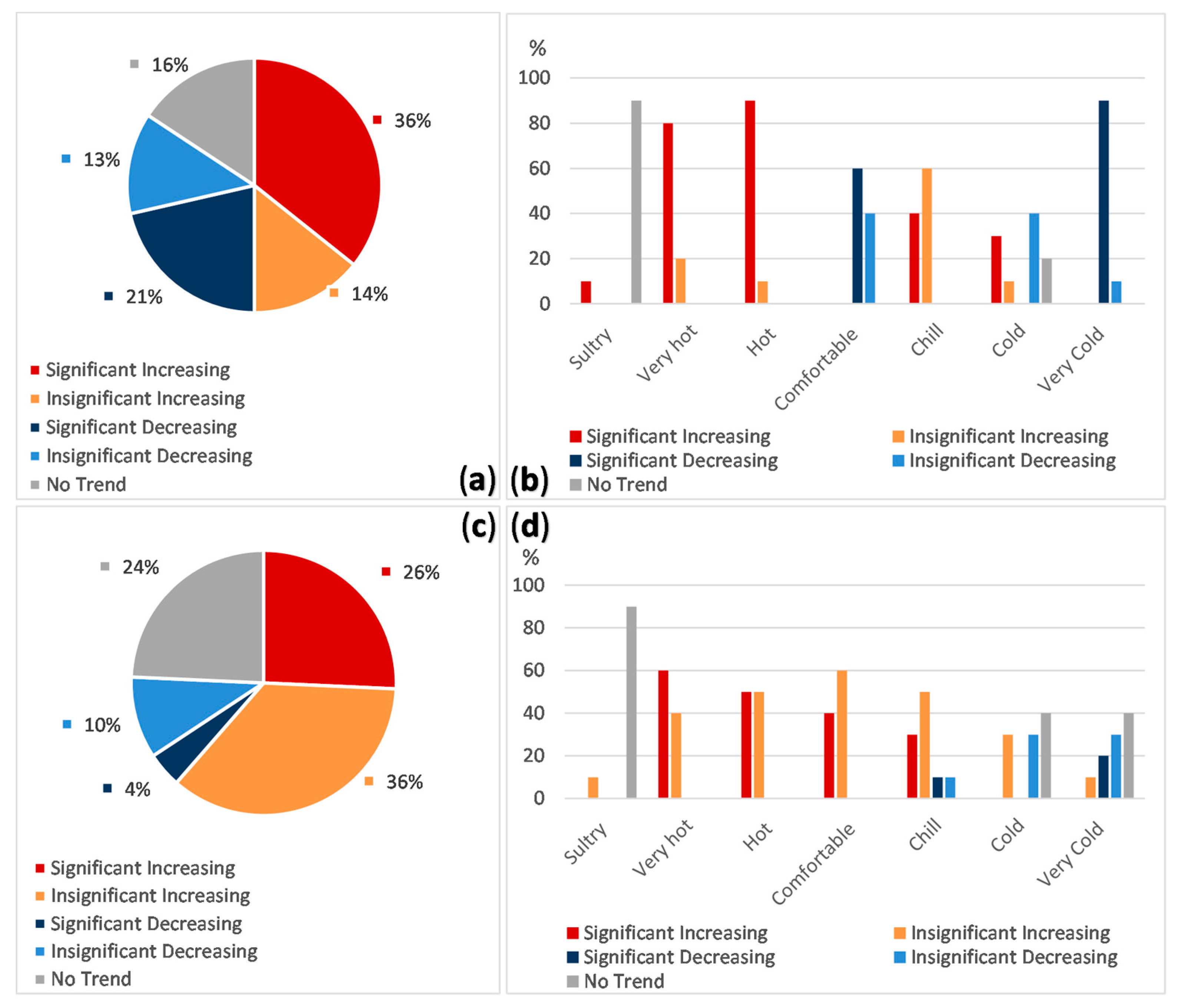
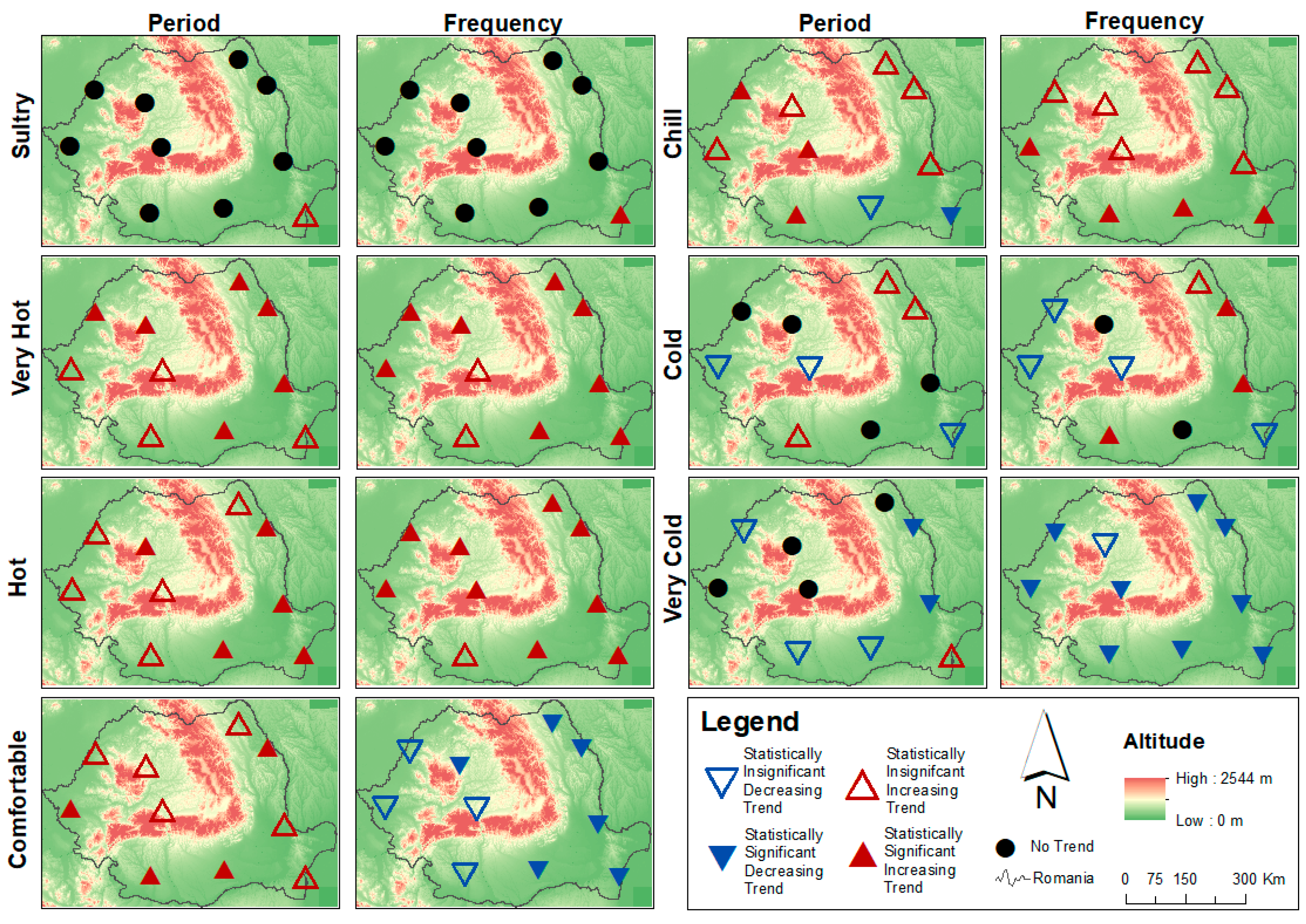
| Weather station * | Latitude (N) | Longitude (E) | Elevation (m) |
|---|---|---|---|
| Botoșani | 47°44′08″ | 26°38′40″ | 161 |
| București-Băneasa | 44°31′00″ | 26°05′00″ | 90 |
| Cluj-Napoca | 46°46′39″ | 23°34′17″ | 410 |
| Constanța | 44°12′49″ | 28°38′41″ | 13 |
| Craiova | 47°18′36″ | 23°52′00″ | 192 |
| Galați | 45°28′23″ | 28°01′56″ | 71 |
| Iași | 47°10′15″ | 27°37′42″ | 102 |
| Oradea | 47°02′10″ | 21°53′51″ | 136 |
| Sibiu | 45°47′21″ | 24°05′28″ | 444 |
| Timișoara | 45°46′17″ | 21°15′35″ | 86 |
| Thermal Sensation/Index | TeK (°C) | TE (°C) | H (W/m2) | UTCI (°C) | THI (Unit) |
|---|---|---|---|---|---|
| Extreme cold stress; | <−40.1 | ||||
| Extremely cold and windy | >2100.1 | ||||
| Very strong cold stress; | −40.00–27.1 | ||||
| Very cold | <1.0 | 1680.1–2100.0 | <40.0 | ||
| Strong cold stress; | −27.0–13.1 | ||||
| Cold | <18.0 | 1.1–9.0 | 1260.1−1680.0 | 40.1–50.0 | |
| Moderate cold stress; | −13.0–0.0 | ||||
| Cool | 18.1–24.0 | 9.1–17.0 | 840.1−1260.0 | ||
| Slight cold stress; | 0.1–+9.0 | ||||
| Slightly cool; | 24.1–32.0 | 630.1–840.0 | |||
| Fresh; | 17.1–21.0 | ||||
| Chill | 50.1–60.0 | ||||
| No thermal stress; | +9.1–+26.0 | ||||
| Comfortable | 32.1–44.0 | 21.1–23.0 | 420.1–630.0 | 60.1–75.0 | |
| Moderate heat stress | +26.1–+32.0 | ||||
| Strong heat stress; | +32.1–+38.0 | ||||
| Slightly sultry; | 44.1–56.0 | ||||
| Hot | 210.1–420.0 | 75.1–80.0 | |||
| Very strong heat stress; | +38.1–+46.0 | ||||
| Sultry; | >56.1 | ||||
| Warm; | 23.1–27.0 | ||||
| Very hot | <210.0 | 80.1–85.0 | |||
| Extreme heat stress; | >+46.1 | ||||
| Sultry | >85.1 |
© 2020 by the authors. Licensee MDPI, Basel, Switzerland. This article is an open access article distributed under the terms and conditions of the Creative Commons Attribution (CC BY) license (http://creativecommons.org/licenses/by/4.0/).
Share and Cite
Banc, Ș.; Croitoru, A.-E.; David, N.A.; Scripcă, A.-S. Changes Detected in Five Bioclimatic Indices in Large Romanian Cities over the Period 1961–2016. Atmosphere 2020, 11, 819. https://doi.org/10.3390/atmos11080819
Banc Ș, Croitoru A-E, David NA, Scripcă A-S. Changes Detected in Five Bioclimatic Indices in Large Romanian Cities over the Period 1961–2016. Atmosphere. 2020; 11(8):819. https://doi.org/10.3390/atmos11080819
Chicago/Turabian StyleBanc, Ștefana, Adina-Eliza Croitoru, Nicoleta Afrodita David, and Andreea-Sabina Scripcă. 2020. "Changes Detected in Five Bioclimatic Indices in Large Romanian Cities over the Period 1961–2016" Atmosphere 11, no. 8: 819. https://doi.org/10.3390/atmos11080819
APA StyleBanc, Ș., Croitoru, A.-E., David, N. A., & Scripcă, A.-S. (2020). Changes Detected in Five Bioclimatic Indices in Large Romanian Cities over the Period 1961–2016. Atmosphere, 11(8), 819. https://doi.org/10.3390/atmos11080819






